We use cookies to make your experience better. To comply with the new e-Privacy directive, we need to ask for your consent to set the cookies. Learn more.
BREDENT MODELS & DUPLICATING SUPPORT
Bredent Master Pin System
INSTRUCTIONS FOR USE
MASTER-PIN SYSTEM
Before using this product, please read and follow these instructions carefully.
1. Indication Range:
The Master-Pin System, Master-Pin (brass) and Master-Pin Sleeve (plastic), is used for exact repositioning of sawed individual dies on the model base of the sawcut model.
2. Processing
2.1 Preparation of the arch
The arch into which the holes for the pins are to be drilled must be ground flat. A plaster trimmer with diamond trimming wheel is perfectly suitable for this purpose. The trimmed base of the arch can be optimized with wet sanding paper (e.g. grain size 600). Let the arch dry well to avoid smearing of the plaster during milling and drilling.
Before drilling and placing the Master-Pins in the arch, grind the lingual resp. palatal inner side of the arch slightly conical (6º) towards the base. This will simplify subsequent removal of the arch from the model base and also serves to firmly position the individual dies on the model base and protect them against torsion.
2.2 Drilling the pin holes
Correct adjusting of the Master-Pin Diatit Tungsten Carbide Drill 1.5 º x 2 mm. in the pin-drilling unit is absolutely required.
The boundary line for drilling at the Master-Pin must be flush with the surface of the arch to receive the exact drilling depth. We recommend that you prepare two drill holes for each die: 1. Drill hole = central fissure; 2. Drill hole = at a distance of 2 to 3 mm. toward the lingual resp. palatal area.
2.3 Gluing in the Master-Pin
Add a drop of cyanoacrylate adhesive (super glue) onto a suitable object (e.g. wax plate). Only the surface of the face of the gluing shaft of the Master-Pin is dipped in the cyanoacrylate adhesive. The Master-Pin is then inserted up to the stop into the drill hole at a right angle towards the base of the arch.
2.4 Separating
After gluing in the Master-Pins, apply Master-Sep (Item #520 002 90) plaster/plaster separating liquid onto the die using a brush.
2.5 Sliding on the Master-Pin Sleeves
Slide the Master-Pin Sleeves onto the Master-Pins so that they are seated flush with the base of the arch. Should two Master-Pins be positioned very closely to each other, the two Master-Pin Sleeves are slid on with the flattened sides facing each other.
2.6 Preparing the base
Prepare several arches using liquid plaster and e.g. the Master-Split System (Item #360 012 4M) without the formation of bubbles.
Since the two Master-Pin Sleeves are 0.5 mm. higher than the Master-Pins, a uniform, defined height is achieved. All Master-Pin Sleeves can be seen at the model base.
2.7 Trimming
Finally, trim the sides of the model to ensure that the arch can be easily removed from the model base.
3. Safety recommendations and hazard warnings
When working with the pin drilling unit, the safety recommendations and hazard warnings of the respective manufacturer must be observed; the same applies to handling of the cyanoacrylate adhesive (super glue).
4. Storage and durability
The Master-Pin System must be stored at room temperature under dry conditions.
5. Other information
The information contained in these instructions for use is always updated according to the latest knowledge and experience. Therefore, we recommend that you read these instructions again before using a new package. These instructions refer to the Master-Pin System, Item #360 012 26, 360 012 25, and 360 011 92.
INSTRUCTIONS FOR USE
MASTER-SEP
Before using this product, please read and follow these instructions carefully.
1. Indication Range:
When producing sawcut models, the special separating liquid Master-Sep is used to separate the arch basis against the plaster.
2. Processing
2.1 A small quantity of Master-Sep is added into a suitable container (e.g. dappen dish, Resi-Mix) depending on the number of arches to be separated.
The bottle must be immediately closed after each use.
Insulate the trimmed arch - with the pins glued in - on the base and the sides up to a height of approximately 5 mm. using a large soft brush. Work quickly and make sure that the surfaces are well coated.
2.2 Special information
Insulate (separate) the arch and the metal pins to optimize soft friction between metal pin and plastic sleeve.
A whitish coating on the pins indicates that the gliding layer is intact. Apply Master-Sep again onto the metal dies to ensure easy removal or insertion of dies that are difficult to remove or insert. This way, first removal of the arch from the model base is much easier.
2.3 Please note:
Do not mix the content of the bottle with other liquids. Never use the separating brush directly from the bottle. After each use, the brush must be cleaned with a paper tissue.
The separating liquid dries very quickly; if metal pins are used, the plastic sleeves are put on only after the liquid has dried. The base of the arch is prepared in the usual way.
As base or model system, we recommend e.g. the Master-Split-System, Item #360 012 4M. After the plaster has hardened (follow times in manufacturers' instructions), trim the model to obtain the desired size. The arch of a sawcut model, which has been dried with compressed air, can now be easily removed.
3. Safety Recommendations and Hazard Warnings
Master-Sep is highly flammable - keep away from sources of ignition; do not smoke.
Master-Sep irritates the eyes, respiratory organs, and skin. Vapors may cause dizziness and sleepiness. Close the bottle after each use and provide adequate ventilation in the working place. Avoid contact with eyes and skin.
3.1 Safety clothing
If required, wear safety gloves.
Handling
For safe handling of the Master-Sep special separating liquid, please follow instructions in Safety Data Sheet.
3.2 Contact
In case of contact with eyes, immediately rinse with water and seek medical assistance
4. Storage and Durability
Master-Sep must be stored at temperatures of 15º to 25º C.
Protect against heat and open flames. Keep the bottle sealed.
Any possible dulling (e.g. due to extended storage under cool conditions) does not indicate that the separating effect is decreasing. It can be reversed by shortly heating up to 30º C.
4.1 Proper disposal
Please follow the instructions provided in the Material Safety Data Sheet.
5. Other Information
This information contained in these instructions for use is always updated according to the latest knowledge and experience. Therefore, we recommend that you read these instructions again before using a new package. These instructions refer to Master-Sep, Item #520 002 90.
MATERIAL SAFETY DATA SHEET
Product Name: MASTER SEP
Product Code: 520 002 90
Before using this product, please read and follow these instructions carefully.
1. Composition/Information on ingredients
Composition: Prepared from fatty acids.
Dissolved in alcohol/hydrocarbon mixtures.
Description:
Hazardous Substances:
Name: CAS-No. Content Hazard symbols Hazard codes
Propan-2-ol 67-63-0 >50% Xi R 36-67
2-Methylpropan-1-ol 78-83-1 5 - 10% Xi R 10 - 37/38 - 41
Kerosene 8008-20-6 10 - 20% Xn R 65
2. Possible Hazards
Hazard Identification: Xn
Hazard R- odes: R 10 Flammable.
R 36/37/38 Irritates eyes, respiratory organs and skin.
R 65 Hazardous to health; may cause damage to the lungs when swallowed.
R 67 Vapors may case daze and drowsiness.
3. First aid procedures:
General Information: Change contaminated clothes immediately.
Skin contact: Remove contaminated clothes, wash skin with plenty of water and soap.
Inhalation: Provide fresh air for affected person.
Eye contact: Flush with pure water for at least 15 minutes immediately; seek medical attention.
Ingestion: Rinse mouth immediately and drink plenty of water; avoid vomiting.
Risk of aspiration! Seek immediate medical attention.
4. Fire fighting procedures:
Suitable extinguishing media: Foam, water, CO2, dry extinguishing media.
Unsuitable extinguishing media:
5. Accidental release procedures:
Precautions - individuals: Do not inhale vapors.
Fresh air supply in closed rooms must be ensured.
Precautions - environment: Observe local environment regulations.
Cleaning up spillage: After spillage, absorb with absorbing material and add into well-sealed containers.
6. Storage and handling:
Storage: Store container firmly sealed.
Store in a dry and well-ventilated room at 15º to 25º C.
Handling: Follow precautions and careful handling just like with all chemicals.
Keep away from food, drinks, and feeding materials.
Keep away from ignition sources - do not s moke.
7. Exposure control/individual protection
Additional information on the layout of technical systems/plants: Work only with explosion-proof equipment and low-sparkling tools.
Constituents with limits relevant to the work are:
CAS-No. Description Type Value Unit
67-63-0 Propan-2-ol TLV 200 ml/m3
or 500 mg/m3
78-83-1 2-Methylpropan-1-ol TLV 100 ml/m3
or 310 mg/m3
Individual:
Respiratory protection: Required equipment in the presence of vapors/aerosols: filter A.
Protection-hands: Protective gloves.
Protection-eyes: Safety goggles.
General procedures with respect to individual hygiene: Proceed just like when handling chemicals. Do not eat, drink, and smoke when working with this product.
8. Physical and chemical properties
Appearance: Low-viscous liquid.
Color: Colorless, transparent.
Odor: Slight bitter almond scent.
Data relevant to safety:
Melting point/interval: Approx. -90º C to -100º C.
Boiling point/interval: Approx. 82 C.
Flash point (ºC): cc: at 12º C
oc: at 15º C.
Ignition point: at 425º C.
Explosion limits: LEL: 2.0 vol. %
UEL: 12 vol. %.
Density (20º C): Approx. 0.78 g/cm3
Viscosity: Low-viscous.
pH-value: Weakly acid (pH 5).
Solubility in: Soluble in toluene, THF; petroleum ether.
Solubility in water: Partly soluble.
9. Stability and reactivity
Conditions to avoid: If used in accordance with the instructions, the product is stable.
Materials to avoid: Cyclopropane; strong oxidants; oleum; potassium-tert.-butoxide.
Avoid contact with alkaline and earth alkaline metals as well as with finely dispersed metals.
Hazardous decomposition products: Prolonged exposure to air may result in the formation of explosive peroxides.
10. Toxicological information
Toxicological tests:
Acute toxicity (LD50): Type Value Species
Oral 4396 - 5500 mg/kg Rat (Propan-2-ol)
Oral 2460 - 3350 mg/kg Rat (2-Methylpropan-1-ol)
Irritating effect:
Skin: Degreasing effect including risk of subsequent inflammations.
Eyes: Strong irritating effect; risk of corneal clouding.
When inhaled or swallowed: Low toxic effect (hemolysis, liver and renal dysfunction)
In case of aspiration, pulmonary edema and pneumonia may result.
Additional toxicological inf: Experience has shown that this product can be safely used if it is handled in accordance with the instructions and if the general rules for work hygiene are observed.
11. Ecological information
According to experience gained so far, this product does not have any negative effects on the environment.
12. Disposal consideration
Product: This product can be burned in a suitable combustion plant/system.
Soiled container: Combustion as special waste.
13. Export regulation
Overland Transport ADR/IDR and GGVS/GGVE (Germany):
GGVS/GGVE class: 3 No./Letter: 5 b
ADR/RID class: 3 No./Letter: 5 b
Designation of the material in this product:
1993 Flammable, liquid material
(Isopropanol, 2-Methylpropan-1-ol, Kerosene)
By Air (ICAO-TI and IATA-DGR):
ICAO/IATA class: 3 UN/ID No.: 1993
Packaging group: II
Correct Technical Designation: Flammable, liquid material
(Isopropanol, 2-Methylpropan-1-ol, Kerosene)
Sea Transport IMDG/GGV See:
IMDG class: 3.3 UN No.: 1993
Correct Technical Designation: Flammable, liquid material
(Isopropanol, 2-Methylpropan-1-ol, Kerosene)
14. Regulatory information
Labeling: According to the Ordinance on Hazardous Materials (GefStoffV).
Hazard symbol and identification: Xn Hazardous to health
Hazard codes: R 10 Flammable
R 36/37/38 Irritates eyes, respiratory organs, and skin.
R 65 Hazardous to health: may cause damage to lungs when swallowed.
R 67 Vapors may cause daze and drowsiness.
Safety codes: S 7/9 Keep container tightly sealed in an adequately ventilated room.
S 13 Keep away from food, drinks, and feeding materials.
S 16 Keep away from sources of ignition - do not smoke.
S 24/25 Avoid contact with skin and eyes.
S 37/39 When working with this product, wear suitable gloves and safety goggles.
15. Other information
Data sheet completed by: Research & Development Dept. - Bredent (Germany).
This Material Safety Data Sheet is provided by way of guide for the use of our product and is correct to the best of our knowledge.
However, we can't offer any guarantee as to its accuracy or exhaustiveness. All chemicals may present unforeseen risks and should be used with caution.
We cannot guarantee that the risks referred above are the only risks present. The final choice of the application of a product is thus the sole responsibility of the user.
Exakto-Form Resin
INSTRUCTIONS FOR USE EXAKTO-FORM MODEL RESIN
Dual component model material, based on polyurethane, for fabricating extremely precise dental models. Thanks to its very low viscosity, it is easily poured into impressions without entrapping air voids. This cost-effective model resin features absolutely precise reproduction of surfaces, dimensional stability and unequaled precision of fit with no expansion whatsoever.
- Presentation
- - Exakto-form model resin is supplied in cans containing 50 g. each of components A and B.
- - 1 assortment includes 6 x 50 g. cans components A and 6 x 50 g. cans of component B.
- - Both components are also available separately.
Directions - Application I
Always follow safety precautions!
Shake the tubs well before opening. Rip the lids off both tubs. To ensure that components A and B are mixed homogeneously, they must be stirred thoroughly before using, to mix the material which has settled.
Pour the contents of the component B tub into the tub containing component A (mixing ratio 1:1). Mix the two components thoroughly within 30 seconds. Working time is 2 to 3 minutes. Separate from impression after 30 minutes; maximum final hardness is achieved after 1.5 hours.
Application I
As this is a polyurethane based, dual-component material, it is inevitable that component B will react prematurely with the mixture in the atmosphere when the can is opened. Therefore, to prevent the moisture in the atmosphere from contacting the material for too long, and consequent premature setting, component B should be used immediately!
Directions - Application II
Should you require a small amount of Exakto-Form model resin (less than 100 g), you can fill the entire contents of tubs A & B into separate syringes and extrude the desired amount into a mixing vessel in a ratio of 1:1. Mix the two components thoroughly within 30 seconds. Working time 2-3 minutes. Separate from impression after 30 minutes. Maximum final hardness attained after 1.5 hours. Please make absolutely certain that you use the remaining material in the syringes within 2 days! Shake the tubs well before opening. Rip the lids off both cans. To ensure that components A & B are mixed homogeneously, they must be stirred thoroughly before each use to mix material which may have settled.
Application II
- Safety Measures
- " Wear protective clothing, gloves, and glasses/face mask.
- " In case of contact with the skin, wash immediately with plenty of soap and water.
- " In case of contact with the eyes, rinse immediately with plenty of soap and water and seek medical attention immediately.
- " Do not inhale vapors - use in well ventilated areas.
- " In case of an accident or sudden indisposition, seek medical attention immediately (if possible, show package label).
- " Keep out of reach of children.
- " Keep out of sewage system, inshore waters, and earth.
- " Keep away from open fire.
- " GGVE/S 6 1 code 19 c.
The general industrial hygiene precautions applying to reactive resins and their hardeners should be followed.
MATERIAL SAFETY DATA SHEET
Product Name: EXAKTO FORM MODEL RESIN COMPONENT A - RESIN
Product Code: 520 001 74, 520 002 80
Before using this product, please read and follow these instructions carefully.
1. Composition/Information on ingredients
Product Description/use: Pigments in a mixture of solvents and polyols.
Hazardous Substances:
Name: CAS-No. Content Hazard symbols Hazard codes
White Spirit --- --- --- R 10
2. Hazard Identification
Hazard codes R 10 flammable.
3. First aid procedures:
Inhalation: Plenty of fresh air and in case of complications seek medical assistance.
Skin contact: Wash skin with soap and rinse with plenty of water; in case of irritation seek medical attention.
Eye contact: Flush immediately with pure water for at least 15 minutes; seek medical attention.
Ingestion: Do not induce vomiting, and seek immediate medical attention.
Others: Remove soaked clothing immediately.
4. Fire fighting procedures:
Suitable extinguishing media: Water-spray, CO2, dry chemicals, foam.
Unsuitable extinguishing media: High-pressure water jet.
Exposure hazards: Thermal decomposition can lead to the generation of irritant vapor and/or fire.
Special equipment: Pressure demand self-contained breathing apparatus should be provided to fire fighters in buildings.
5. Accidental release procedures:
Precautions - individuals: Wear protective equipment; avoid contact with eyes and skin. Do not breathe vapor; always use in a well-ventilated area.
Precautions - environment: Stop leaks as soon as possible and avoid discharge into environment.
Cleaning up spillage: Absorb with mineral fillers (such as sand, diatomaceous earth,) and store in a well-sealed, suitable container.
6. Storage and handling:
Storage: Store in a well-sealed container in a well-ventilated room. Do not expose to temperatures exceeding 30º C; store away from food.
Handling: Avoid contact with eyes or skin; always use in a well-ventilated area; do not breathe vapor. Do not smoke. Keep away from sources of ignition.
7. Exposure control/individual protection
Individual:
Protection-hands: Protective gloves..
Protection-eyes: Protective glasses.
Protection-skin: Working coat (cotton).
General procedures with respect to individual hygiene: Avoid inhalation; avoid eye and skin contact. Do not eat, drink or smoke while.
working. After working, wash your hands with soap and water.
8. Physical and chemical properties:
Appearance:Liquid.
Color: Opaque, greenish.
Odor: Typical.
Data relevant to safety:
Acidity (pH): 10
Flash point: 42º C.
Ignition point: 420º C.
Self-inflammation: None.
Vapor pressure (20º C): 7-8 mbar.
9. Stability and reactivity:
Conditions to avoid: Do not expose to temperatures exceeding 50 C or below 5º C.
Materials to avoid: Avoid direct contact to strong oxidants or isocyanates.
Hazardous decomposition products: Thermal decomposition leads to the generation of irritant vapors.
10. Toxicological information:
Toxicological evaluation: The toxicological properties have not been fully determined.
Irritating properties: Direct contact with skin or eyes may cause irritation or reddening.
Sensitization: None have been reported yet.
Carcinogenic, teratogenic, or mutagenic effects: None have been reported yet.
11. Ecological information:
Avoid discharge into the environment.
12. Disposal consideration:
Product/Soiled container: Both need to be classified as chemical waste material and disposed of in agreement with your local and national legislation.
13. Export regulation
By land:
ADR/RID/GGVS/GGVE class: 3 No./Letter: 31.c)
Warning symbol: F Hazard No.: 30 Material No.: 1993
By air:
ICAO/IATA class: 3 UN/ID No.: 1993 Verp. Grp.: III/309
Correct technical name: White spirit.
14. Regulatory information:
Hazard symbol and identification: Flammable.
Hazard codes: R 10 Flammable.
Safety codes: S 16 Keep away from sources of ignition.
S 24/25 Avoid contact with eyes or skin.
15. Other information
Data sheet completed by: Research & Development Dept. - Bredent (Germany).
This Material Safety Data Sheet is provided by way of guide for the use of our product and is
correct to the best of our knowledge.
However, we can't offer any guarantee as to its accuracy or
exhaustiveness. All chemicals may present unforeseen risks and should be used with caution.
We cannot guarantee that the risks referred above are the only risks present. The final choice of the application of a
product is thus the sole responsibility of the user.
MATERIAL SAFETY DATA SHEET
Product Name: EXAKTO FORM MODEL RESIN COMPONENT B - HARDENER
Product Code: 520 001 73, 520 002 80
Before using this product, please read and follow these instructions carefully.
1. Composition/Information on ingredients
Product Description/use: Hardener of a two compound model resin.
Name: CAS-No. Content Hazard symbols Hazard codes.
Dyphenylmethane-4,4' 101-68-8 Xn R 20; 36/37/38; 42
Diisocyanate.
2. Hazard Identification
Hazard codes: R 20 Harmful by inhalation.
R 36/37/38 Irritating to eyes, respiratory system & skin.
R 42 Sensitization may be caused by inhalation.
3. First aid procedures:
Inhalation: Plenty of fresh air and in case of complications seek medical assistance.
Skin contact: Wash skin with soap and rinse with plenty of water; in case of irritation seek medical attention.
Eye contact: Flush immediately with pure water for at least 15 minutes; seek medical attention.
Ingestion: Do not induce vomiting, and seek immediate medical attention.
Others: Remove soaked clothing immediately.
4. Fire fighting procedures:
Suitable extinguishing media: Water spray, CO2, dry chemicals, foam.
Unsuitable extinguishing media: High-pressure water jet.
Exposure hazards: High temperatures lead to the generation of irritant vapor and/or fire.
5. Accidental release procedures:
Precautions - individuals: Wear protective equipment; avoid contact with eyes and skin. Do not breathe vapor; always use in a well-ventilated area.
Precautions - environment: Stop leaks as soon as possible and avoid discharge into environment.
Cleaning up spillage: Absorb with mineral fillers (such as sand, diatomaceous earth,) and store in a well-sealed suitable container.
6. Storage and handling:
Storage: Store in a well-sealed glass container in a dry, well-ventilated room. Store at temperatures between 18 and 22º C; store away from food.
Handling: Avoid contact with eyes or skin; always use in a well-ventilated area; do not breathe vapor. Do not smoke.
7. Exposure control/individual protection
Constituents with limits relevant to the work area:
CAS-No.: Description: Type Value Unit
101-68-8 Diphenylmethane-4,4'-diisocyanate MAK 0.05 ppm
Individual:
Protection-hands: Protective gloves.
Protection-eyes: Protective glasses are recommended.
Protection-skin: Working coat (cotton).
General procedures with respect to individual hygiene: Avoid inhalation; avoid eye and skin contact. Do not eat, drink or smoke while working. After working, wash your hands with soap and rinse with water thoroughly.
8. Physical and chemical properties:
8. Physical and chemical properties
Appearance: Opaque liquid.
Color: Yellowish.
Odor: Typical.
Data relevant to safety:
Flash point: > 100º C.
Ignition point: 240º C.
Self-inflammation: No.
Vapor pressures (20º C): 8 mbar.
Specific density (20 C): 1.76 g/ml.
9. Stability and reactivity:
Conditions to avoid: Avoid temperatures exceeding 30 C and below 18º C.
Materials to avoid: Avoid peroxides, amins, alcohols and water.
Hazardous decomposition products: Reaction with water in a sealed container may cause a rising pressure and leads to the explosive destruction of the container.
10. Toxicological information:
Toxicological evaluation:
Acute toxicity:
LD50/LC50: Substance Species Kind of exposure
15000 mg/kg Diphenylmethane- Rat Oral
4,4'-diisocyanate
Irritating properties: Irritates mucous membranes, eyes and skin.
Sensitization: May cause sensitization symptoms like asthma.
Carcinogenic, teratogenic, or mutagenic effects: None have been reported yet.
11. Ecological information:
Avoid discharge into the environment.
12. Disposal consideration:
Product: This product needs to be classified as chemical waste material and disposed of in agreement with your local and national legislation.
Soiled container: Empty the bottle entirely; then dispose of in agreement with your local and national legislation.
13. Export regulation
Transport: Non-regulated.
14. Regulatory information:
Hazard symbol & identification: Xi = Irritant; F = Highly Flammable.
Hazardous substances: Methyl methacrylate.
Hazard codes: R 11 Highly flammable.
R 36/37/38 Irritates eyes, respiratory organs, and skin.
R 43 Direct skin contact may cause sensitization.
Safety codes: S 9 Store in well ventilated rooms only.
S 16 Avoid direct contact with sources of ignition-do not smoke.
15. Other information
Data sheet completed by: Research & Development Dept. - Bredent (Germany).
This Material Safety Data Sheet is provided by way of guide for the use of our product and is
correct to the best of our knowledge.
However, we can't offer any guarantee as to its accuracy or
exhaustiveness. All chemicals may present unforeseen risks and should be used with caution.
We cannot guarantee that the risks referred above are the only risks present. The final choice of the application of a
product is thus the sole responsibility of the user.

1.Prior to mixing, each component must be stirred so that a homogeneous mixture is obtained. Mix the sediment completely.

2.Add component A to component B; empty tin completely.

3.Mix Exakto-Form approximately 30 seconds until a uniform color is obtained.

4.Two tins of Exakto-Form are sufficient to produce 2-3 complete dental arches.

5.The material can be removed after 30 minutes. Final hardness is achieved after 90 minutes. Then the model can be trimmed.

6.If a base for the model is to be produced with Exakto-Form, the model must first be insulated with Exakto-Form Insulating Liquid.

7.Due to its high edge stability, Exakto-form is perfectly suitable for precision-fit bridge and crown work.

8.Any technique can be used for sawing Exakto-Form models. Adopting a new technique is not required.

9.If smaller quantities are used, fill component A and B into separate syringes.

10.Pour equal quantities of Exakto-Form into a silicone beaker (approximately 2 ml for one die) and mix to obtain a homogeneous material. Please note, material in syringes must be used within 5 days.

11.Pour Exakto-Form into the impression. The excellent flow properties prevent the formation of bubbles even in impressions with thin edges.

12.The hardened resin can be drilled and trimmed. The stability avoids dimensional changes and guarantees precise models.
Exaktosil N 21 Duplicating Silicone
Exaktosil N 21 Duplicating Silicone Kit
- Pouring silicone for the duplication of models.
- Components A and B are mixed in a 1:1 ratio. The components are stirred until they are evenly mixed.
- Then power mix under vacuum for 30 seconds.

Exaktosil Silicone features particularly low shrinkage and virtually bubble-free duplicating molds.

Model can be de-molded after 30-40 minutes.

One of the advantages of Exaktosil is its excellent reproduction of detail.

Exaktosil consistent quality ensures precision accuracy when duplicating.
Haptosil D Silicone Components
Haptosil D - kneading silicone
Before using the product, please read these instructions for use carefully.
Haptosil D MSDS1. Product discription
haptosil D is an addition-curing kneading silicone with a Shore A hardness of 90 for the use in dental laboratories.
2. Indication range
haptosil D is used for the fabrication of keys, repair models and checkbites.
3. Safety recommendations and hazard warnings
No special measures required. After eye contact, rinse eyes under running water for several minutes with lid being opened.
If complaints persist, seek medical attention.
4. Processing
Use the enclosed dosing spoons to remove the two components from the jars. Make sure not to mix up dosing spoons and lids when removing material from the jars! haptosil D base and catalyst paste are mixed in the ratio of 1:1 and the paste is mixed until it is completely free from streaks (approx. 30 sec). Make sure to adhere exactly to the given mixing ratio to achieve the required setting times and final hardness. The jars must be sealed after the use.
It is recommended to wear vinyl gloves when mixing the pastes to avoid contamination. Store at room temperature. Higher temperatures will reduce the processing and setting time and lower temperatures will increase them. Materials containing sulfur or amine may result in retarded setting or even prevent setting (e.g. various milling oils, latex gloves.
5. Technical data (times from beginning of mixing, calculated at 23° C)
Mixing time: 30 seconds
Processing time: 60 seconds
Setting time: 7 minutes
Shore A hardness (after 24 hrs): ≥ 90 Shore A
6. Disposal
The hardened silicone can be disposed of together with commercial or household waste.
7. Additional information
The information contained in these instructions for use is always updated according to the latest knowledge and experience.
Therefore we recommend to read the instructions for use again before using a new package
Any recommendations concerning the use are based on bredent‘s experience and tests, and can only be considered to provide approximate values. Our products are subject to continuous further development. Therefore we reserve the right to perform changes in the design and composition.
Multisil-Mask Soft
Quick and economical processing with the cartridge and the specially adjusted silicone allow trouble-free direct application into the impression or the matrix. The natural color of the gingival mask supports perfect shade determination of the veneer. Overdimensioning of margins is recognized immediately.
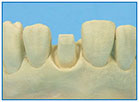
The gingival situation on the unsawed sawcut model...
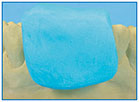
...is reproduced using Exaktosil C kneading silicone and then the arch is sawed.
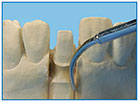
The sawcut are coated with wax.
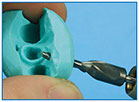
Openings (inlet & outlet) are drilled into the matrix using the locating matrix drill and Multi-Sep is applied.
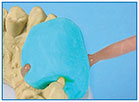
The dispensing device with cartridge and canula is held to the opening. While applying the material from the dosing device, the matrix is fixed on the model...
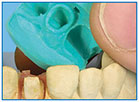
...to obtain the correct position of the gingival mask.





